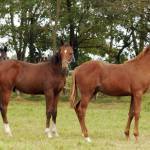Yearling Growth on Alfalfa and Soybean Meal Studied

The purpose of the study was to compare growth rates and nitrogen balances in young fillies fed amounts of alfalfa or oil seed proteins that contained the same amount of nitrogen. Both protein amount and type are important in the diets of growing horses because certain amino acids cannot be produced in the horse’s body and must be provided by ingested food. The site of protein digestion is important to optimal absorption. It was assumed the protein in the forage would be digested predominantly in the large intestine, while digestion of the oil seed protein would take place primarily in the small intestine.
How was the study performed?
Sixteen yearling fillies of Quarter Horse breeding were paired by age and weight, and the pairs were then split to produce two groups of eight horses. Horses in Group 1 were fed a diet of coastal Bermuda grass hay and a corn-based concentrate supplemented with soybean meal to reach a level of 13% crude protein. Horses in Group 2 were fed long-stemmed alfalfa hay and a similar concentrate that did not contain soybean meal. The level of crude protein was again approximately 13%.
Body weight, rump fat thickness, and measurements of various body parts (wither and hip height, body length, heart girth, and limb bone circumferences) were taken when the study began and every 28 days throughout the trial. Blood samples were taken every 14 days before the morning feeding. During the digestion trial (final four days of the study), urine and feces were collected. Dry matter and nitrogen contents of feed, hay, and feces were determined, and amino acids in feed samples were analyzed.
Horses were allowed to eat for three hours at each feeding. Intake averaged 6.3 kilograms for the soybean meal diet and 6.2 kilograms for the alfalfa diet, amounting to 1.9% of body weight.
This was slightly less than would have been consumed with ad libitum feeding. Intakes were equalized to ensure that energy and nitrogen consumption would be similar between the two diets. Differences in growth could then be related to protein source.
What results were found?
Physical growth was similar for horses in both dietary groups. Average daily weight gain was 0.44 kilograms per day for all fillies. This moderate rate of growth is consistent with the level of feed intake. Body measurements and rump fat thickness were not different by dietary treatment. Nitrogen intakes were also similar and were sufficient to meet NRC requirements for energy.
Apparent digestibility of nitrogen was within the expected range, and measurements of blood urea nitrogen were similar. Fillies fed the diet supplemented with soybean meal retained slightly more nitrogen than did fillies fed the alfalfa diet.
Fillies fed soybean meal also had higher concentrations of osteocalcin both early and late in the study, indicating a greater amount of activity by osteoblasts (cells associated with the formation of bone). Fillies on the alfalfa diet showed a drop in osteocalcin by day 14, indicating the alfalfa-fed horses experienced somewhat less osteoblastic activity than those fed soybean meal.
What do the results tell us about feeding yearling fillies?
Provision of high-quality protein is important to support optimal growth and weight gain in young horses. In this study, little difference was found in weight gain or growth measurements when yearling fillies were fed either soybean meal or alfalfa as a protein source.
At least for the length of time of this study, either diet could be expected to meet the needs of young growing horses. The authors point out that the measurements of growth used in this study may not have been sensitive enough to reveal any effects of lowered amino acid absorption on skeletal or muscle tissue development. They also felt it was not clear that the results would be similar in horses fed ad libitum and growing at a faster rate.
The full text of this report can be found in the Journal of Equine Veterinary Science, Vol. 18, No. 4 (1998), pp. 266-269.
The study “Growth of yearling fillies fed alfalfa or soybean meal,” was conducted by LH Wall III, GD Potter, PG Gibbs, GW Brumbaugh Texas A & M University, College Station, Texas.








